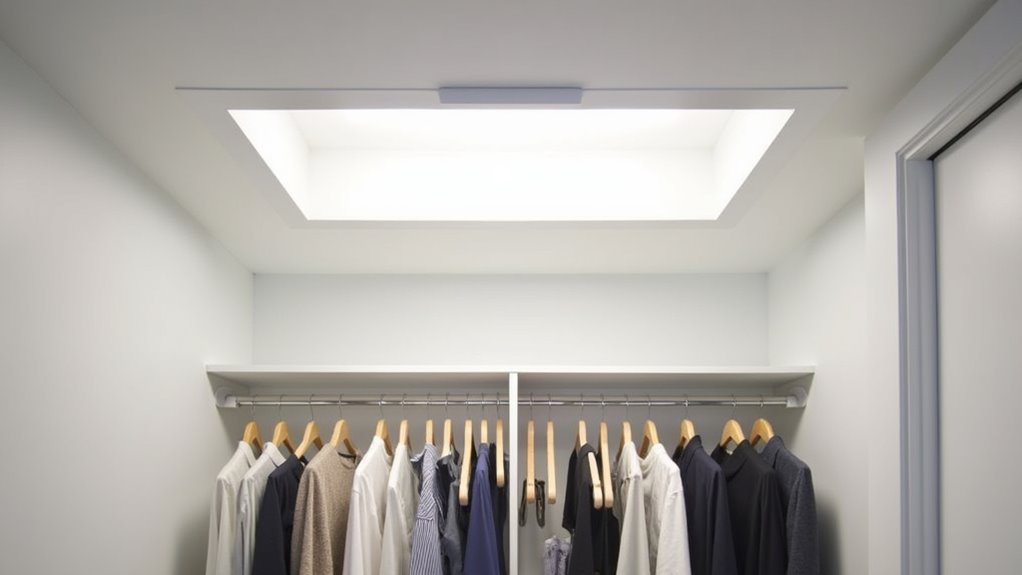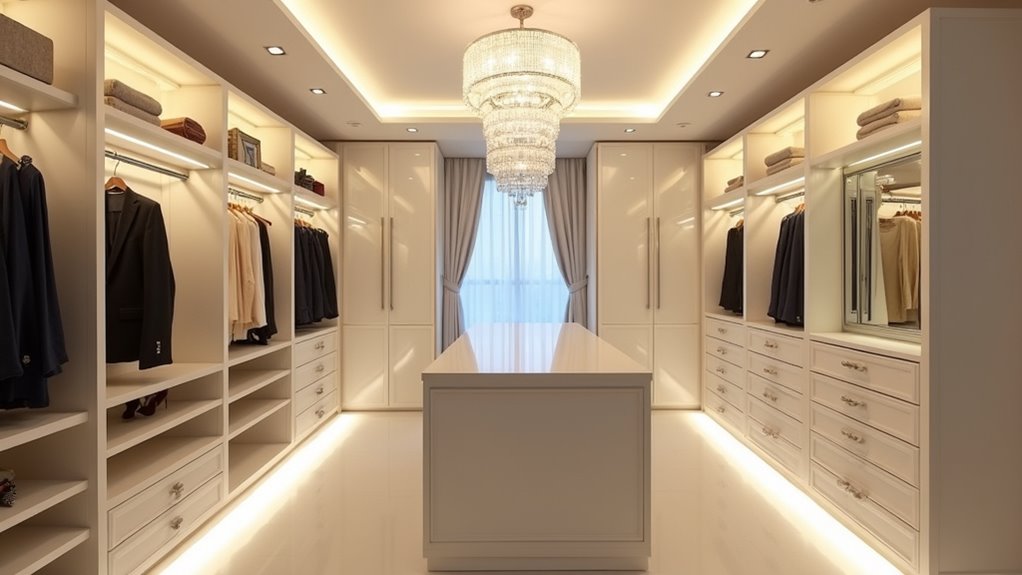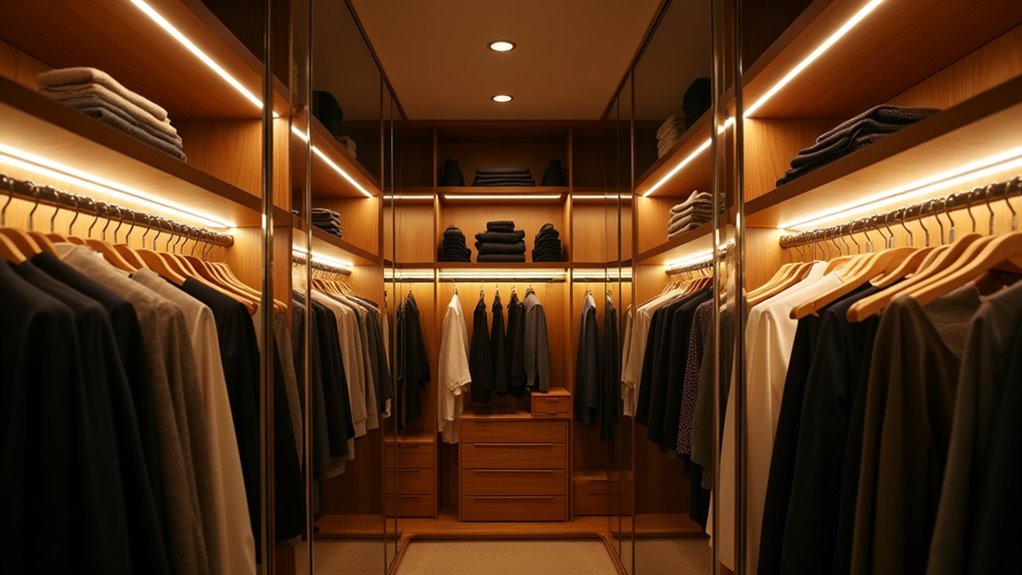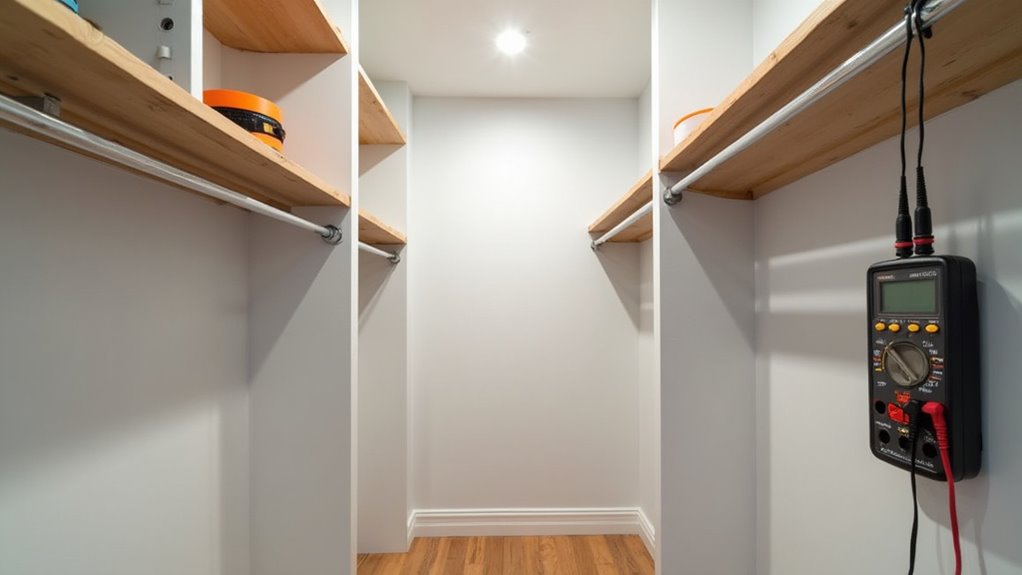You’ll transform your dark closet by installing wireless LED lights with motion sensors, which provide hands-free illumination through adhesive-backed mounting or magnetic attachment systems, no tools required. Select fixtures offering 200-400 lumens for medium spaces, paired with daylight spectrum (5000K-6500K) color temperatures that deliver superior chromatic fidelity for garment selection. These energy-efficient solutions consume just 5-20 watts while operating cool-to-touch, eliminating fire hazards in confined quarters. Strategic placement under shelves and along vertical surfaces maximizes coverage while the integrated technology guarantees you’ll find comprehensive optimization techniques ahead.
Why Wireless LED Lights Are the Perfect Solution for Dark Closets
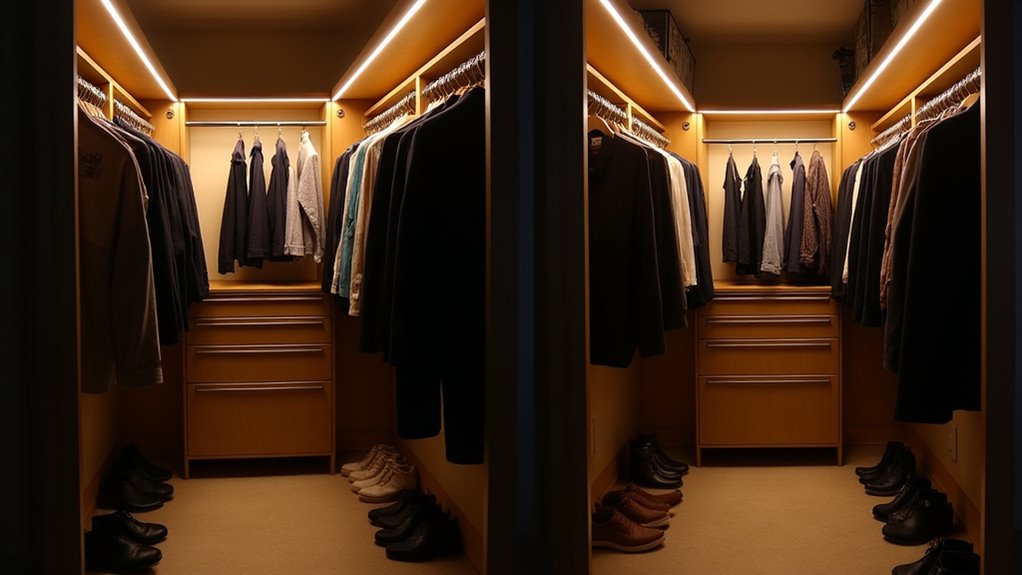
When conventional lighting systems fall short in confined storage environments, wireless LED solutions emerge as the ideal convergence of form and function. You’ll achieve superior energy efficiency through 75% reduced consumption compared to traditional bulbs, while their cool-to-the-touch operation eliminates fire hazards in confined quarters. The wireless configuration removes trip hazards and enables tool-free installation via adhesive mounts or magnetic systems, perfect for rentals requiring non-invasive modifications.
You’ll benefit from maintenance free operation spanning 25,000–50,000 hours, drastically minimizing replacement cycles. These systems offer adjustable lighting settings across diverse color temperatures, allowing you to customize ambiance from warm white to daylight. LEDs withstand temperature fluctuations that commonly occur in closet environments, maintaining consistent performance regardless of seasonal changes. The absence of UV radiation prevents fabric deterioration, while compact form factors, strips, pucks, or bars, integrate seamlessly into architectural constraints, elevating both functionality and spatial aesthetics. Strategic placement of flexible LED strips beneath shelves and above clothing rods transforms shadowy corners into well-illuminated zones where every garment remains visible. Wireless puck lights eliminate the need for electrical work, as these battery-powered fixtures can be strategically installed throughout your closet without professional assistance.
Understanding Motion Sensor Technology for Hands-Free Closet Illumination
As you navigate confined storage spaces with arms laden with garments or organizational bins, motion sensor technology transforms closet illumination into an autonomous, friction-free experience. Passive infrared sensors detect thermal energy shifts within 100–120-degree detection angles, triggering instantaneous light activation across 10–20-foot ranges. This hands-free operation eliminates tactile switch engagement while preventing fumbling incidents in darkness.
Motion sensor sensitivity adjustments enable calibration for varying closet dimensions and traffic patterns, ensuring responsive detection without false triggers. Integrated auto-off timers (20 seconds to one minute) conserve energy by terminating illumination during vacancy periods. Advanced fixtures incorporate automated scheduling controls and daylight-mode functions, restricting activation to designated intervals. Rechargeable USB charging eliminates battery replacement cycles, with fixtures powering through standard 5V adapters and included charging cords for extended operational sustainability. Combined with LED efficiency, 10-watt output matching 50-watt incandescent equivalents, these intelligent systems deliver sustainable, maintenance-minimized illumination customized to contemporary spatial design requirements.
Quick and Easy Installation Methods That Require No Professional Help
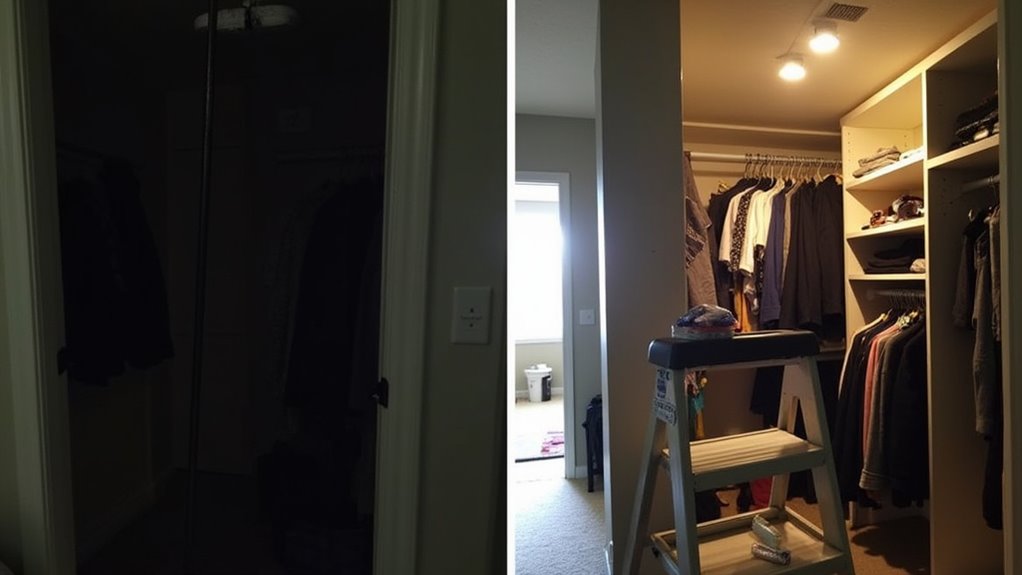
While traditional hardwired fixtures necessitate electrical expertise and structural modifications, contemporary wireless lighting systems democratize closet illumination through installation methodologies requiring only basic household implements. Adhesive-backed mounting platforms, magnetic attachment systems, and tool-free bracket assemblies eliminate drywall penetration and circuit integration, preserving architectural finishes while accommodating rental restrictions.
Peel-and-stick LED panels adhere directly to ceilings and shelving surfaces following simple cleaning protocols, while magnetic strips attach to steel strapping, enabling DIY customization options through flexible repositioning. Under-shelf units integrate via adhesive or minimal screws, maintaining discreet installation aesthetics beneath storage platforms. Motion-sensor puck lights replicate recessed lighting profiles without structural alterations, and hook-based mounting systems support temporary placements. Preparing surfaces with alcohol before application ensures optimal adhesion for double-sided tape installations. Complete installation typically requires under sixty minutes, transforming dark storage spaces into professionally illuminated environments without contractor intervention.
Choosing the Right Brightness and Color Temperature for Your Closet Space
- Lumen Allocation by Spatial Dimensions: Small enclosures (≤6 ft²) require 100-200 lumens, medium spaces (6-12 ft²) need 200-400 lumens, while expansive walk-ins (12+ ft²) demand 400+ lumens with supplementary task lighting for focused zones.
- Temperature Selection for Accurate Color Rendering: Daylight spectrum (5000K-6500K) delivers ideal chromatic fidelity for distinguishing similar hues, while cool white (3500K-4100K) provides crisp, functional illumination without the harshness problematic in mirrored applications. Warm white options (2700K-3000K) generate a cozy atmosphere but may distort the appearance of cool-toned garments. CCT tunable fixtures enable personalized adjustment across the 2700-5000K range to match individual preferences and specific wardrobe requirements.
- Integrated Ambient-Task Approach: Combine balanced lighting levels throughout the space with targeted 200-400 lumen accents, creating both functional clarity and refined atmospheric quality that improves daily interaction patterns. Installing dimmer-compatible LED fixtures allows you to control brightness levels based on time of day while extending the operational lifespan of your lighting system.
Energy Efficiency and Long-Term Cost Savings With LED Technology
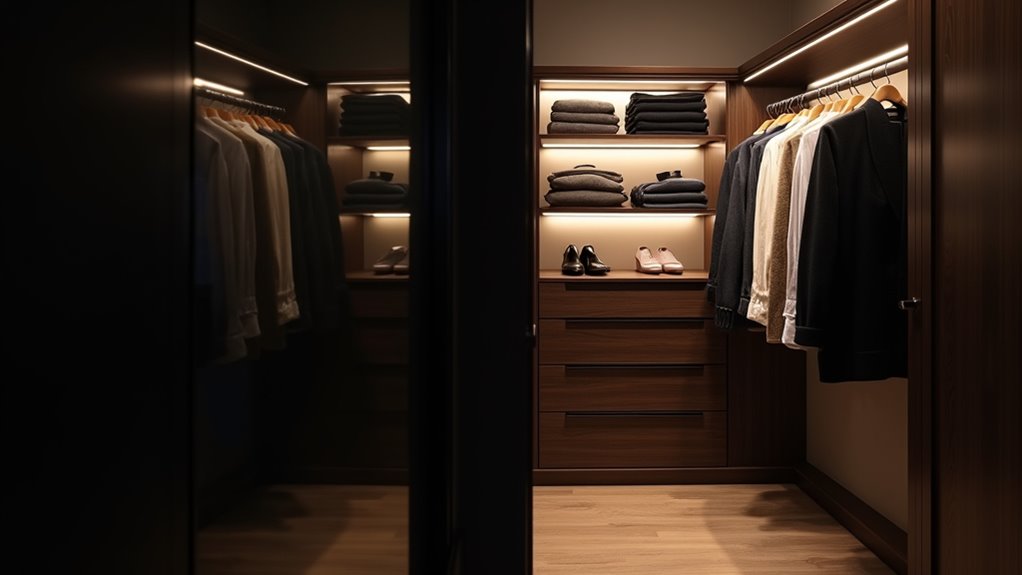
LED technology transforms your closet lighting investment through measurable reductions in operational expenses and environmental footprint. You’ll experience immediate energy savings, up to 75% less consumption compared to incandescent alternatives, while the extended 25,000-hour lifespan eliminates frequent replacement cycles that disrupt your space’s functionality. This efficiency paradigm delivers compounding economic advantages: lower electricity bills, reduced maintenance interventions, and minimized carbon emissions that align with contemporary sustainable design standards. The directional light emission of LEDs eliminates the need for reflectors and diffusers in your closet space, ensuring that illumination reaches exactly where you need it without wasted light dispersion. LED lights convert more energy into light rather than heat, making them significantly more efficient for closet installations where temperature control matters. Integrating smart lighting technologies like motion sensors further optimizes energy consumption by activating illumination only when needed, maximizing both convenience and efficiency in your closet space.
Reduced Electricity Bills Over Time
Because traditional incandescent fixtures convert up to 90% of their energy into heat rather than visible light, they impose a substantial and persistent drain on household electricity resources. LED wireless solutions deliver transformative utility bill reductions through optimized energy conversion, consuming merely 5–20 watts compared to 60-watt incandescent alternatives. You’ll realize operational cost savings of up to 90% for equivalent luminosity.
Quantifiable Financial Impact:
- Daily operational expense: A 10-watt LED costs just $0.036 per 24-hour cycle at standard $0.15/kWh rates, versus $0.22 for incandescent equivalents
- Accelerated ROI: Measurable monthly and annual cost reductions guarantee faster investment recovery
- Minimized HVAC demand: Reduced heat emission decreases cooling requirements, compounding energy savings beyond direct lighting expenditure
Smart dimming and motion-sensing features further refine consumption patterns, maximizing efficiency. The extended average rated life of LED bulbs significantly reduces maintenance and replacement costs over time. These fixtures last 15 times longer than traditional bulbs, leading to substantial financial savings on both operations and maintenance expenses.
Extended LED Lifespan Benefits
Beyond immediate reductions in monthly utility expenses, wireless LED closet lighting delivers exceptional value through remarkable longevity that fundamentally reshapes ownership economics. You’ll appreciate operational lifespans reaching 25,000 to 50,000 hours, far exceeding incandescent and CFL alternatives, which translates to nearly a decade of consistent illumination with typical daily use. This durability yields reduced maintenance requirements, eliminating frequent bulb changes in hard-to-reach installations while minimizing disruption to your space.
LEDs maintain at least 70% of original brightness throughout their rated life, ensuring an upgraded visual experience with uniform illumination and zero warm-up delay. Their minimal heat output, converting 95% of energy into light, protects delicate fabrics while improving safety in enclosed environments. Combined with declining upfront costs and lower electronic waste generation, these fixtures deliver superior long-term return on investment.
Lower Environmental Impact Overall
When selecting wireless closet lighting, you’re making decisions that extend well beyond aesthetics; your choice directly influences environmental sustainability through energy consumption patterns and resource utilization. LED-based wireless solutions deliver measurable environmental advantages:
- Energy Efficiency Translation to Emissions Reduction: LEDs consume 75% less energy than incandescent alternatives, directly cutting greenhouse gas emissions from electricity generation. By 2035, widespread LED adoption could eliminate over 569 TWh annually, equivalent to shutting down 92 large power plants.
- Waste Stream Minimization: Extended LED lifespans mean fewer replacements, reducing landfill burden. Unlike CFLs, LEDs contain no mercury, while improved recycling programs enable material recovery from end-of-life units.
- Supply Chain Impact Reduction: Decreased replacement frequency translates to lowered transportation emissions and reduced packaging waste, supporting circular economy principles through sustainable manufacturing processes.
Safety Features That Make Wireless Closet Lighting a Smart Choice
Wireless closet lighting systems integrate multiple layers of protective technology that address both immediate hazards and long-term safety concerns in confined storage environments. LED technology eliminates heat buildup risks while battery-powered operation removes electrical shock exposure entirely. Motion sensors with 15-foot ranges and 100° detection angles activate illumination only when needed, supporting fire prevention guidelines through auto-off timers that eliminate accidental overnight operation. You’ll find battery safety precautions built directly into these systems through indicator lights that prevent overcharging and degradation. The adhesive mounting eliminates cord-related tripping hazards while maintaining structural integrity of closet surfaces. Cool-temperature operation, combined with long-lifespan LED bulbs, minimizes maintenance interventions and glass breakage risks. Manufacturer warranties extending up to six years provide accountability for defect-related safety concerns.
Creative Placement Ideas to Maximize Light Coverage and Eliminate Shadows
Strategic light positioning transforms closet functionality by addressing the spatial challenges inherent in confined storage environments. Reflective surface optimization through corner-mounted profiles guarantees light diffusion, while shadow casting prevention requires layered fixtures at opposing heights and angles.
Maximize coverage through intentional placement:
- Vertical integration – Install LED strips along interior sides and behind hanging rods to create balanced illumination that eliminates rear shadows and amplifies garment visibility.
- Zoned lighting architecture – Dedicate specific fixtures to shelves, hanging areas, and drawers, positioning each for prime task performance and ambient enhancement.
- Multi-directional approach – Combine ceiling-mounted panels with under-shelf strips and door-integrated pucks to achieve thorough light distribution across all functional zones.
This systematic approach ascertains uniform brightness while maintaining aesthetic coherence throughout your storage space.
Frequently Asked Questions
Can Wireless Closet Lights Work in Extremely Small or Narrow Closet Spaces?
Wireless closet lights excel in extremely small or narrow spaces due to their compact, adaptable design. You’ll find slim LED pucks and adhesive strips install seamlessly where traditional recessed lighting options won’t fit, maximizing your available surface area. Their stick-on mounting requires no hardwiring, while customizable brightness levels prevent over-illumination in confined quarters. You can position fixtures strategically on ceilings, walls, or doors to achieve ideal light distribution, ensuring even the most restrictive closets maintain functional illumination without compromising aesthetic principles or spatial integrity.
How Often Do Rechargeable Wireless Closet Lights Need to Be Charged?
Charging frequency depends entirely on your usage pattern and desired aesthetic function. In motion-sensor mode, you’ll recharge every 30-90 days, optimizing battery life expectancy while maintaining seamless illumination design. Always-on configurations require weekly charging but deliver continuous ambient lighting. Battery life expectancy ranges from 10-13 hours of constant operation to three months in auto mode. Your lighting design goals, whether creating perpetual glow or motion-activated accents, directly influence how often you’ll need to recharge these streamlined fixtures.
Are Wireless Closet Lights Compatible With Existing Smart Home Automation Systems?
Yes, many wireless closet lights integrate seamlessly with smart home systems through Bluetooth or Wi-Fi connectivity. You’ll find compatibility with Amazon Alexa and Google Home enables voice-activated control and app-based dimming adjustments. However, connectivity issues can arise with weaker signal strength in enclosed spaces, affecting responsive automation. Furthermore, battery life considerations become critical when maintaining consistent smart home synchronization, as constant wireless communication drains power more quickly than standalone operation, requiring strategic placement and regular charging schedules.
What Happens if Motion Sensors Activate Too Frequently in High-Traffic Areas?
Frequent activation compromises both functionality and aesthetic cohesion in your space. Nuisance activations disrupt visual continuity, creating jarring light shifts that undermine your carefully curated atmosphere. You’ll experience accelerated battery drain issues, requiring constant maintenance that detracts from seamless design integration. The repetitive cycling degrades component longevity while generating inconsistent illumination patterns. To preserve your lighting scheme’s elegance, you’ll need to recalibrate sensor sensitivity, optimize placement angles, and consider dual-technology solutions that distinguish intentional movement from environmental interference.
Can Adhesive-Mounted Lights Damage Walls or Closet Surfaces When Removed?
Yes, adhesive-mounted lights pose risks to your closet’s architectural finishes. You’ll encounter potential paint damage, particularly with latex-based wall treatments, as the bonding agents can compromise surface integrity during removal. Potential surface scratching occurs when you’re separating mounted fixtures from substrates. To preserve your space’s aesthetic cohesion, you should test adhesion strength on inconspicuous areas initially, apply controlled heat during removal, and utilize non-abrasive tools. These preventative measures protect your closet’s design integrity while maintaining its refined visual appeal.

